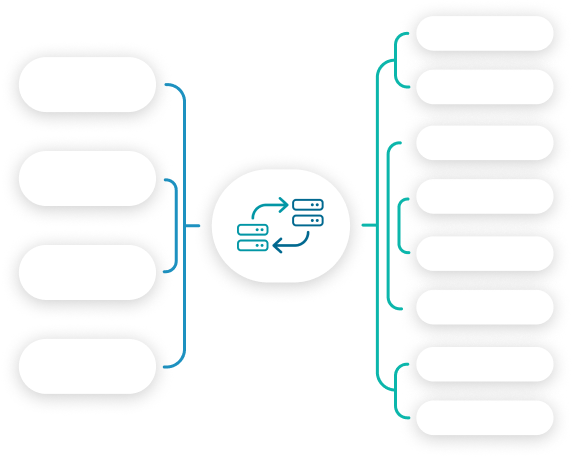The Misalignment Between Data Migration and Agile Development
Agile methodologies have become the dominant approach for developing software solutions, prized for their flexibility, iterative development, and focus on evolving requirements.
However, when it comes to data migration—especially into target systems being built using Agile—this flexibility can cause challenges that are often overlooked. While it’s possible to manage data migration within a programme that’s developing the target solution in an Agile manner, the misalignment between the two processes often leads to rework, delays, and communication failures.
This article explores why data migration, with its structured demands across planning, design, mapping, build, testing, and implementation, clashes with Agile’s iterative, flexible nature—and how Agile development of the target solution introduces additional complexity.
1. Planning - The Dangers of Shifting Targets
Agile development often results in a shifting target for the data migration team. This creates challenges in the planning phase, which demands certainty about data structures, field formats, and business rules in the target system. When the target solution evolves throughout Agile sprints, the migration plan risks becoming outdated, leading to delays and rework.
Data migration requires comprehensive upfront planning—clarity on the end state of the system is critical for the migration to be successful. The Agile approach, which thrives on just-in-time planning and flexibility, creates a mismatch here. Migration teams often need to re-plan and adjust based on the evolving state of the target system, causing misalignment and frustration.
2. Design and Mapping - Dependency on Stability
Designing and mapping the migration involves understanding the source data structure and aligning it with the target system's architecture. These tasks require precise knowledge of how data will flow and be transformed, which is heavily dependent on the stability of the target system's data models.

In Agile, the data model in the target solution can change even late into development. This creates challenges for the migration team. If data fields, relationships, or business rules evolve, it forces the team to remap fields, rework transformation logic, and often revisit fundamental design choices. The cascading effect of such changes creates unnecessary rework and can extend timelines.
This constant re-alignment becomes a drain on resources and creates inefficiencies. Agile’s flexibility, while advantageous for feature development, introduces risks when it disrupts the foundational work of data migration.
3. Build - Complex Dependencies and Incomplete Solutions
The build phase—creating the ETL (Extract, Transform, Load) scripts or migration tools—depends on having a well-defined and stable target system. Agile’s iterative development can leave the migration team working with incomplete or changing system architectures, which complicates the build process.
For example, if the business logic or data structures are not fully defined, migration teams must either wait or make assumptions that could lead to rework. As Agile sprints continue, new features can be added to the target system, forcing the migration team to adapt their build processes repeatedly.
Agile’s strength lies in allowing incremental development, but data migration requires a holistic view to ensure the entire ETL process works in harmony. Without stable system endpoints, the build phase becomes fraught with delays and inefficiencies.
4. Testing - The Challenge of Binary Outcomes
 Agile encourages iterative testing, where each feature is tested and refined across sprints. However, data migration testing is binary: either the data is migrated correctly, or it isn’t. Partial or incomplete migration testing can miss critical issues, leading to significant risks at cutover.
Agile encourages iterative testing, where each feature is tested and refined across sprints. However, data migration testing is binary: either the data is migrated correctly, or it isn’t. Partial or incomplete migration testing can miss critical issues, leading to significant risks at cutover.
If the target system is still evolving during development, the migration team must continuously adjust their testing scenarios, often revalidating data as new features or changes come online. This creates a feedback loop of rework, where data migration testing cycles are elongated as Agile-driven changes to the target solution keep occurring.
Moreover, Agile’s incremental testing doesn’t translate well for data migration because of the dependency on the entirety of the system being stable to validate the integrity of data transfers.
5. Implementation - Coordination and Communication Failures
The final cutover is a high-stakes event, often requiring precise coordination between the development and migration teams. If there has been poor communication about changes in the target solution during Agile sprints, the migration team may face serious issues during implementation. Data may be migrated to fields that no longer exist, or business rules may have changed, rendering the migration logic incorrect.
Without a robust communication channel between the Agile development team and the migration team, last-minute changes can create significant risk. This is especially critical when Agile teams continue to push new features close to the implementation date, leaving the migration team scrambling to adapt.
Conclusion - Bridging the Gap Between Agile Development and Data Migration
Agile methodologies are invaluable for software development, enabling teams to deliver value quickly and respond to change. However, when data migration is part of the picture, the inherent misalignment between Agile’s iterative, evolving approach and data migration’s need for stability and predictability becomes clear.
Migrating data into an Agile-developed target solution can work, but it introduces challenges around rework, testing delays, and communication failures. Without disciplined coordination and early stabilization of key system components, these issues can cascade into costly delays.
Ultimately, the success of data migration in an Agile environment depends on a hybrid approach—leveraging Agile’s flexibility for development while ensuring structured, clear communication and stability where migration is concerned. By recognizing and addressing these friction points early in the project, organizations can reduce the risk of failure and better align their workstreams for success.

Andrew Boswell
Director